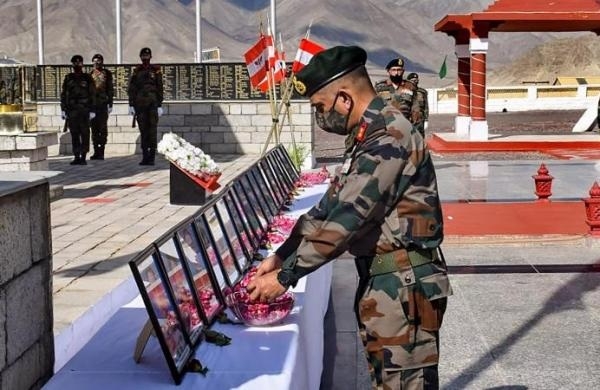PARADIGM SHIFT
17 Jun 2021 11:24:35

THE honourable recall of the martyrdom of 20 Indian bravehearts during the Galwan Valley encounter with Chinese troops one year after the happening, is not just a patriotic symbolism of the nation, but also embodies a wonderful paradigm shift in leadership thought and action. If in military terms, the Galwan Valley encounter is a moment to be proud of, it also offers a point of national pride that India’s national leadership has shed all its earlier inhibitions and initiated a concerted action to safeguard the country’s strategic security both on short and long term basis. The leadership took certain immediate measures to face the Chinese challenge and has continued with those as a matter of India’s new security doctrine of which a perennial commitment to building a comprehensive security system is the core.
At the end of one year after the Galwan Valley encounter, what the nation must recall is not just the martyrdom of the soldiers, but also this welcome shift in security paradigm. Of course, a massive resource mobilisation was necessary with a sense of urgency as the Chinese posed one of the worst challenges in recent times. Against the backdrop of the emergent situation, the national leader took on-the-spot decisions for a very quick and comprehensive mobilisation of financial, military, industrial and diplomatic initiatives that astonished the world no end. Factually, the Chinese had never anticipated such a response and felt rather paralysed in a way as India stood equally tall and strong to ward of the ugly designs. It is this gain that needs to be celebrated -- besides the recall of martyrdom of 20 Indian bravehearts in Galwan Valley encounter.
There is no doubt that the Chinese challenge is far from over. And Indian leadership has realised this very correctly. Hence the continued mobilisation of all possible resources to keep security infrastructure -- of which men and material are integral parts -- in a battle-ready condition on a near-permanent basis. This cannot be achieved only by wishing; it requires a lot of systematic management and organising on a sustained basis. As an extension of the immediate task at hand, the Indian leadership gave a massive push to a new industrial activity that has begun making the country self-sufficient on most matters of ordnance merchandise production.
As part of this thought-process, the leadership also gave a massive push to the process of acquisition of critical arms, ammunitions and weapons-systems on all fronts -- the Army, the Air Force, and the Navy. True, many of these initiatives will reach the stage of fruition in the next few years. But then, this has to be an ongoing process so that the country’s defence-preparedness remains pepped up all the time. There is no doubt that India’s Army, Air Force and Navy are among the top forces in their respective categories in the world. But the current push is going to take them a couple slots higher on the ratings ladder in the next some years. What is critical to be kept in mind is that this massive push is not only in terms of numbers -- of men, and materials -- but also in terms of doctrinal alterations to accommodate changing security needs. It is this gain that needs to be celebrated by the nation at this stage. For, until a few years ago, India’s security doctrine was rather a system locked in slow-motion thought and action.
That picture no longer exists, thanks to the no-nonsense, quick response of the government to the emerging security challenge. This should have been done at least 20 years earlier, but the national leadership did not somehow pay appropriate attention to that need -- as if it was waiting for some catastrophe to hit the nation. But the picture started assuming brighter colours in the past years as the new national leadership became active on two fronts -- one, a deeper diplomatic connect with China in particular; and two, a parallel push to defence-preparedness no matter what was happening at the negotiating table. That was why India was not caught off-guard first in Doka La and then in eastern Ladakh. This paradigm shift is the core message of the Galwan Valley metaphor.